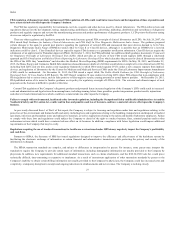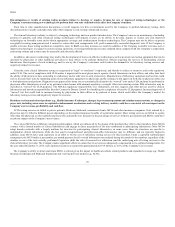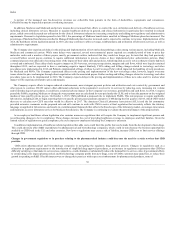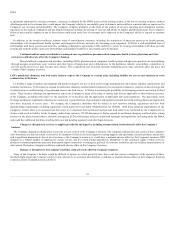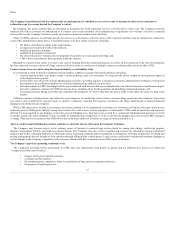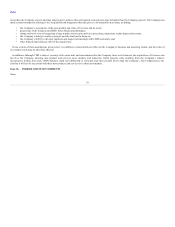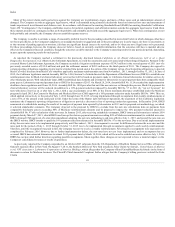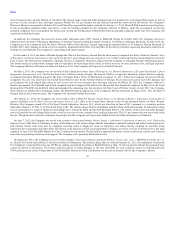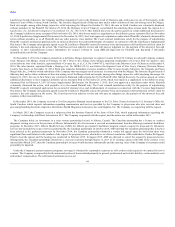LabCorp 2015 Annual Report Download - page 34
Download and view the complete annual report
Please find page 34 of the 2015 LabCorp annual report below. You can navigate through the pages in the report by either clicking on the pages listed below, or by using the keyword search tool below to find specific information within the annual report.
Index
• the timing of and charges associated with completed acquisitions or other events; and
• changes in the mix of the Company's services.
The Company believes that operating results for any particular quarter are not necessarily a meaningful indication of future results. While fluctuations in
the Company's quarterly operating results could negatively or positively affect the market price of the Company's common stock, these fluctuations may not
be related to the Company's future overall operating performance.
CDD’s revenues depend greatly on the expenditures made by the pharmaceutical and biotechnology industries in R&D. In some instances, companies in
these industries are reliant on their ability to raise capital in order to fund their R&D projects. Accordingly, economic factors and industry trends affecting
CDD’s clients in these industries may also affect CDD. If companies in these industries were to reduce the number of R&D projects they conduct or outsource,
whether through inability to raise capital, industry trends, economic conditions or otherwise, CDD could be materially adversely affected.
CDD's early development services utilize animals in preclinical testing of the safety and efficacy of drugs, and also breed and sell animals for biomedical
research. Such activities are required for the development of new medicines and medical devices under regulatory regimes in the U.S., Europe, Japan and
other countries. Acts of vandalism and other acts by animal rights activists who object to the use of animals in drug development could have an adverse effect
on the Company.
It is important that research products be free of diseases, including infectious diseases. The presence of diseases can distort or compromise the quality of
research results, cause loss of animals in CDD’s inventory, result in harm to humans or outside animal populations if the disease is not contained to animals in
inventory, or result in other losses. Such results could harm CDD’s reputation or have an adverse effect on CDD's financial condition, results of operations,
and cash flows.
The conduct of animal research at CDD’s facilities must be in compliance with the AWA, which governs the care and use of warm-blooded animals used
for research in the U.S. other than laboratory rats, mice and chickens, and is enforced through periodic inspections by the USDA. The AWA establishes
facility standards regarding several aspects of animal welfare, including housing, ventilation, lighting, feeding and watering, handling, veterinary care and
recordkeeping.CDD complies with licensing and registration requirement standards set by the USDA and similar agencies in foreign jurisdictions such as the
European Union and China for the care and use of regulated species. If the USDA determines that CDD’s equipment, facilities, laboratories or processes do
not comply with applicable AWA standards, it may issue an inspection report documenting the deficiencies and setting deadlines for any required corrective
actions. For continued noncompliance, the USDA may impose fines, suspend and/or revoke animal research licenses, or confiscate research animals. Other
countries where CDD conducts business may have similar laws with which CDD must also comply.
The loss of key management personnel or the inability to attract and retain experienced and qualified employees at the Company’s clinical laboratories
and drug development facilities could adversely affect the business. The success of the Company is dependent in part on the efforts of key members of its
management team. Success in maintaining the Company’s leadership position in genomic and other advanced testing technologies and in drug development
will depend in part on the Company’s ability to attract and retain skilled research professionals. In addition, the success of the Company’s clinical
laboratories also depends on employing and retaining qualified and experienced laboratory professionals, including specialists, who perform clinical
laboratory testing services. In the future, if competition for the services of these professionals increases, the Company may not be able to continue to attract
and retain individuals in its markets. The Company’s revenues and earnings could be adversely affected if a significant number of professionals terminate
their relationship with the Company or become unable or unwilling to continue their employment.
The Company is a party to collective bargaining agreements with various labor unions and is subject to employment and labor laws and unionization
activity in the U.S. and other countries in which it conducts business. Disputes with regard to the terms of
34





